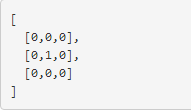[LeetCode]63 不同的路徑總數之二
阿新 • • 發佈:2018-12-26
Unique Paths II(不同的路徑總數之二)
【難度:Medium】
Follow up for “Unique Paths”:
Now consider if some obstacles are added to the grids. How many unique paths would there be?
An obstacle and empty space is marked as 1 and 0 respectively in the grid.
For example,
There is one obstacle in the middle of a 3x3 grid as illustrated below.
LeetCode 62題的擴充套件,為機器人增加了障礙物,0表示空地,1表示障礙,同樣求從左上角到右下角不同的走法總數。
解題思路
在62題的基礎上解決這個問題,但需要考慮的是,機器人不能簡單地向下或向右走,要判斷是否有障礙物,因此左邊界和上邊界的初始化也要根據上一個點的狀態來設定,同樣使用動態規劃來完成。
c++程式碼如下:
class Solution {
public:
int uniquePathsWithObstacles(vector<vector<int>>& obstacleGrid) {
if (obstacleGrid.empty())
return 
